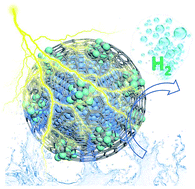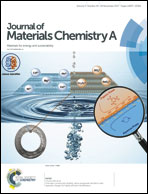Graphitized carbon-coated vanadium carbide nanoboscages modified by nickel with enhanced electrocatalytic activity for hydrogen evolution in both acid and alkaline solutions†
Abstract
Developing active and stable electrocatalysts based on earth-abundant elements for water splitting is an important challenge for efficient energy conversion and storage. Herein, a controllable structural engineering technique to construct 3-dimensional (3D) vanadium carbide (VC) nanoboscages with a graphitic carbon coating is reported by inventively employing Ni as a crystallization inducer. The incorporation of Ni at the atomic scale into the vanadate precursor not only promotes the generation of active VC during the carbonization process but also catalyzes the in situ formation of graphitized carbon on the surface of the VC to construct a carbon coating. Due to the excellent electronic properties of active sites and improved charge and mass transport capability derived from the unique structure and morphology, the Ni-VC@C samples are endowed with favorable catalytic activities. The optimized Ni-VC@C achieves high HER efficiencies in both acid (η@10 mA cm−2 = 138 mV) and alkaline (η@10 mA cm−2 = 146 mV) environments with excellent stability, surpassing those of carbide-based HER catalysts reported previously. The “metal induced crystallization” strategy for preparing such nanostructures opens up opportunities for exploring low-cost, high performance electrocatalysts for various applications.



 Please wait while we load your content...
Please wait while we load your content...